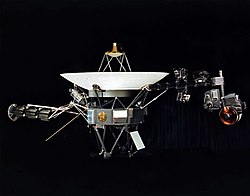Proteus (moon)
Proteus or Neptune VIII, is the second biggest moon of Neptune, and its biggest close moon. It is named after Proteus, the shape-changing sea god of Greek mythology.
 | |
| Discovery | |
|---|---|
| Discovered by | Voyager 2 Stephen P. Synnott |
| Discovery date | ~June 16, 1989 |
| Orbital characteristics | |
| Epoch 18 August 1989 | |
| Periapsis | 117,584 ± 10 km |
| Apoapsis | 117,709 ± 10 km |
| 117,647 ± 1 km (0.00079 AU) | |
| Eccentricity | 0.00053 ± 0.00009 |
| 1.12231477 ± 0.00000002 d | |
Average orbital speed | 7.623 km/s |
| Inclination | 0.524° (to Neptune equator) 0.026 ± 0.007° (to local Laplace plane) |
| Satellite of | Neptune |
| Physical characteristics | |
| Dimensions | 440×416×404 km (± ~15 km) |
| Volume | 3.4 ± 0.3 ×107km³ |
| Mass | ~4.4×1019 kg (estimate) |
Mean density | ~1.3 g/cm³ (estimate) |
| ~0.06 m/s2 (0.006 g) | |
| ~0.16 km/s | |
| synchronous | |
| zero | |
| Albedo | 0.096 |
| Temperature | ~51 K mean (estimate) |
| 20.3 | |
Proteus was found from the images taken by Voyager 2 probe during the Neptune flyby in 1989. It got the designation S/1989 N 1. Stephen P. Synnott and Bradford A. Smith said (IAUC 4806) its discovery on July 7, 1989, speaking only of “17 frames taken over 21 days”, which gives a discovery date of sometime before June 16. The name was given on 16 September 1991.
Proteus is more than 400 kilometres in diameter, bigger than Nereid, another moon of Neptune. However, it was not found by Earth-based telescopes because it is so close to the planet that it is lost in the glare of reflected sunlight.
Proteus is one of the darkest objects in the solar system. Like Saturn's moon Phoebe, it reflects only 6 percent of the sunlight that hits it. Proteus is very cratered, showing no sign of any geological changes. It is also not a sphere; scientists believe Proteus is about as big as a body of its density can be without being pulled into a spherical shape by its own gravity. Saturn's moon Mimas has much more spherical shape despite being less massive than Proteus.
Proteus (moon) Media
Voyager 2 image of Proteus, digitally processed showing surface features
Original caption*SHADED RELIEF MAP OF PROTEUS[1]*Proteus.gif is a shaded relief map of Proteus, a small inner satellite of Neptune. As with all maps, it is the cartographer's interpretation and not all features are necessarily certain given the limited data available - this interpretation stretches the data as far as is feasible.*The original map was published in its full form
Other websites
- Proteus Profile Archived 2007-08-01 at the Wayback Machine by NASA's Solar System Exploration
- IAU Circular describing the discovery of S/1989 N 1 (with mandatory IAU web policy statement)
- Proteus page on The Nine Planets
- Proteus, A Moon Of Neptune on Views of the Solar System
- Ted Stryk's Proteus Page Archived 2007-10-04 at the Wayback Machine




